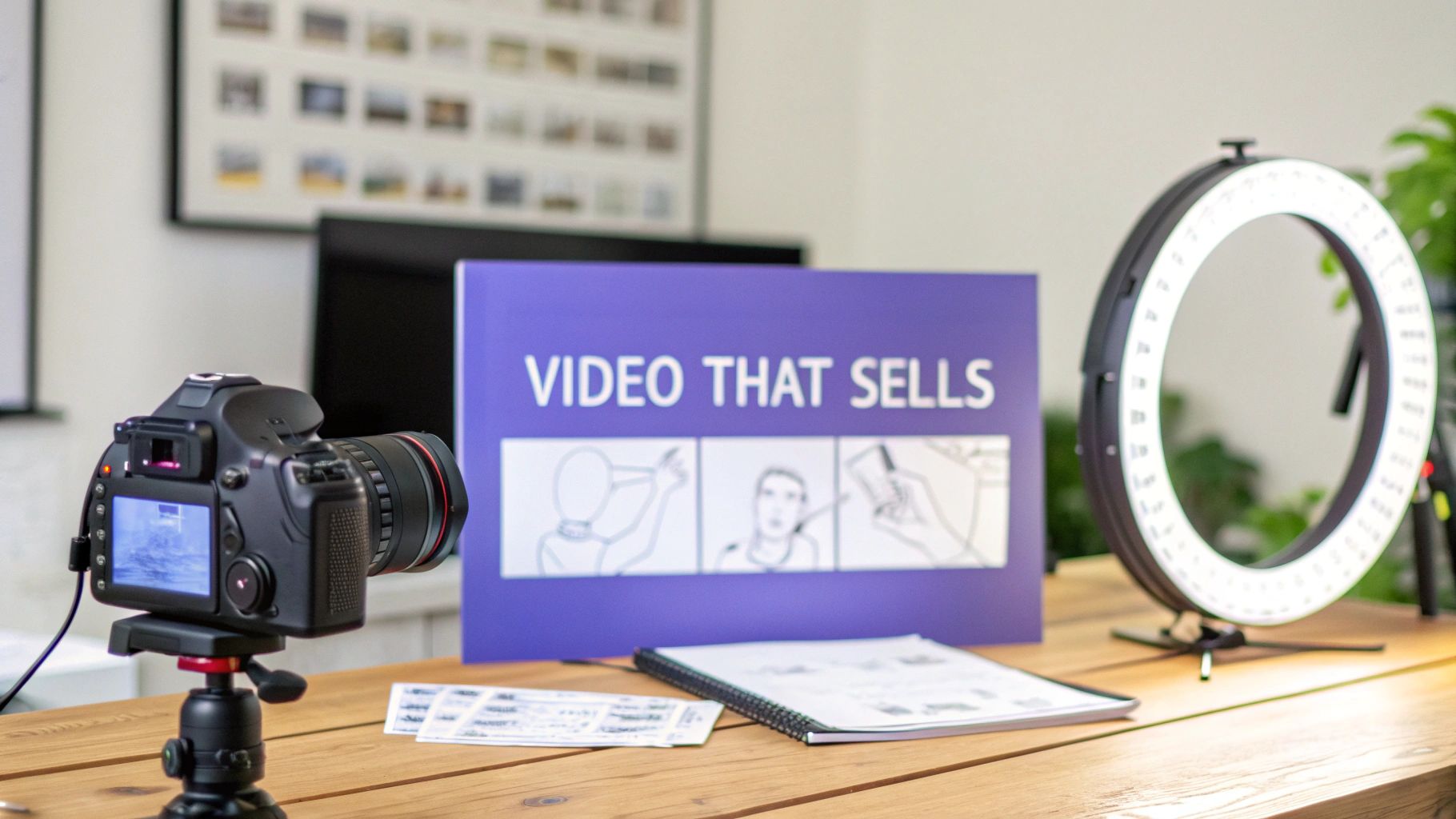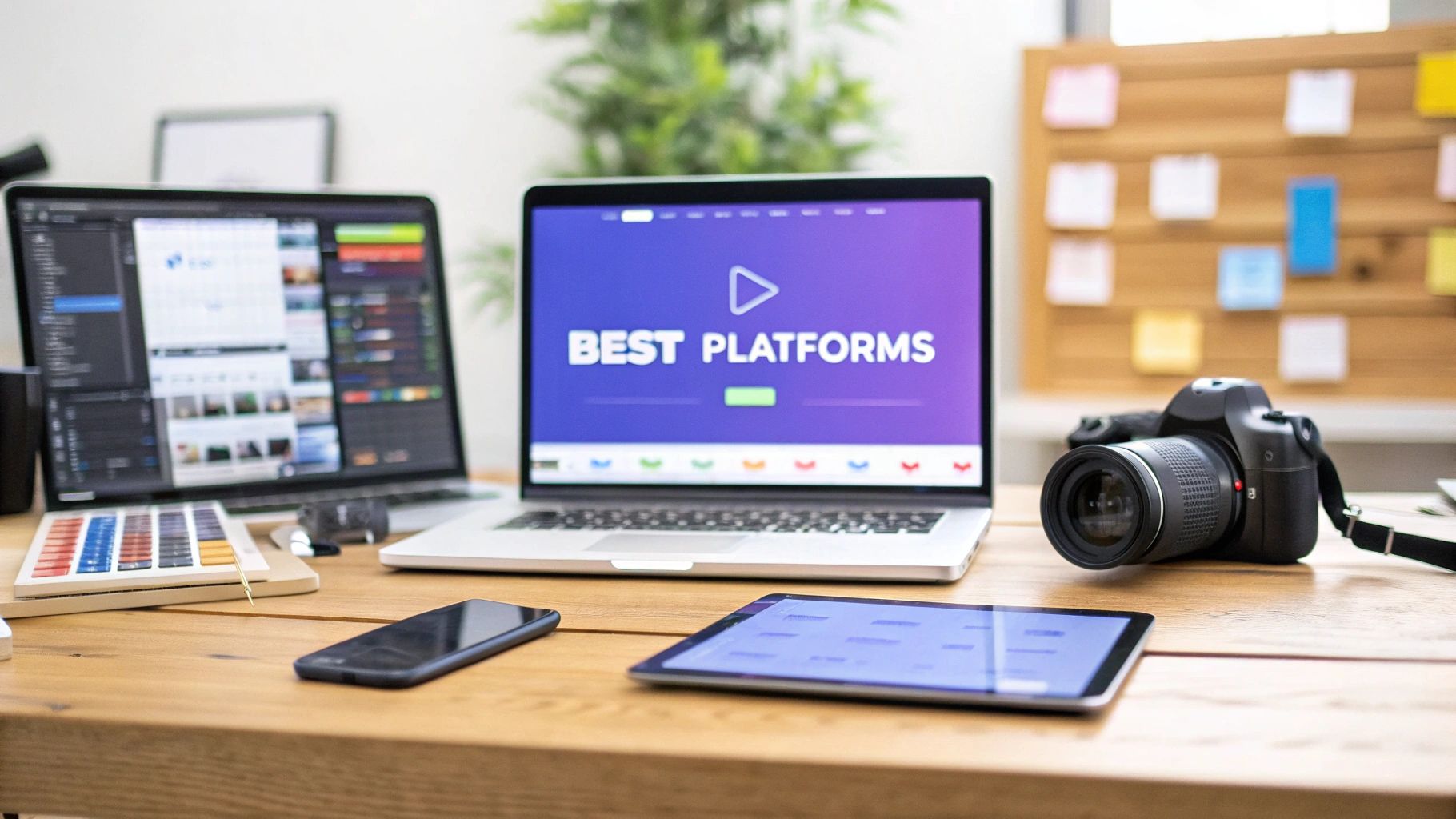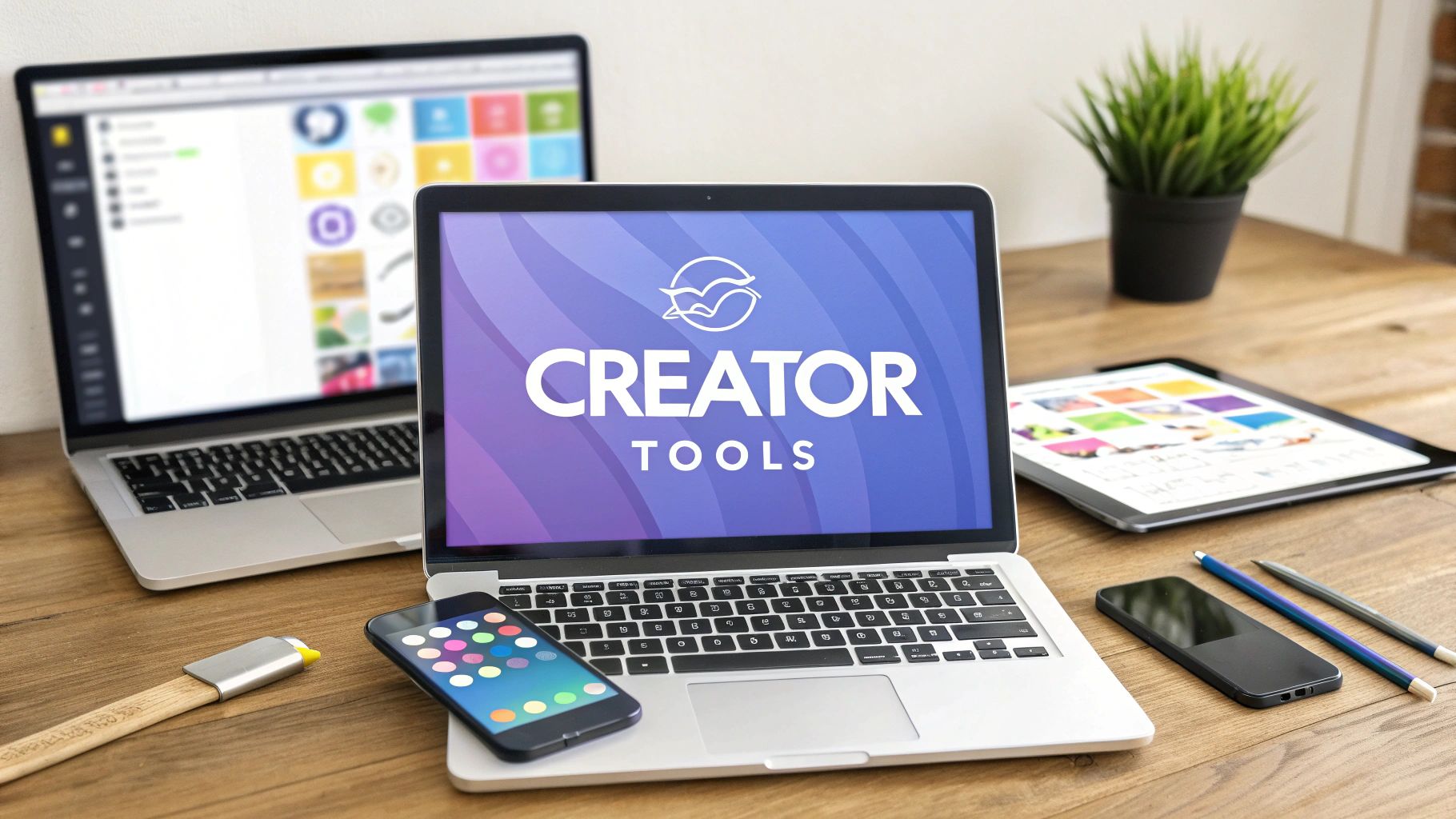When you break it down, creating a great product video follows a pretty straightforward path: figure out your message, shoot to show the benefits, and edit to make it pop. This used to be a game only big-budget companies could play, but tools like Sprello's AI workflow have opened the doors for everyone to create content that actually sells.
Let's walk through the whole process together, from that first spark of an idea to getting your finished video out into the world.
Why Product Videos Are Your Secret Sales Weapon
Telling you "video is important" is useless advice. What's actually important is understanding why. The magic of a product video is its power to build trust and get people to a "yes" faster. It’s an experience that a flat image or a block of text just can't compete with. A good video doesn't just show off your product; it tells a story and shows people exactly how it will make their lives better.
When you show your product in action, you’re answering questions before they're even asked. You stop listing features and start demonstrating real-world value. That visual proof is incredibly convincing and melts away a ton of that "should I buy it?" hesitation.
The Numbers Don't Lie
The move to video isn't just a fleeting trend—it's a massive shift in how people shop and learn. The data makes this crystal clear.
By 2025, video marketing has become non-negotiable, with 89% of companies using it as a core marketing tool. A staggering 93% of marketers see a positive ROI from their video campaigns. This isn't just about getting views; it's about real business growth. Videos are directly responsible for lead generation for 88% of marketers and have boosted website traffic for 82%. You can dig deeper into these video marketing stats over at Sundaysky.com.
"A great product video does more than just showcase features. It solves a problem for the viewer right before their eyes, making the decision to buy feel like the most logical next step."
Building Trust Through Transparency
In marketing today, authenticity is everything. Product videos, especially the ones that have that raw, user-generated content (UGC) vibe, give people an honest peek at what they're actually buying. This instantly builds credibility and creates a real connection.
- It puts a face to the name: Videos make your brand feel more human and relatable, not just another faceless online shop.
- It shows the product in real life: When potential buyers see the product in a realistic setting, they can easily imagine it in their own lives.
- It lowers the risk: Seeing something work exactly as promised is powerful social proof. It eases worries about quality and whether the product will deliver.
Of course, creating a fantastic video is only half the battle. To really see results, you have to know where it fits in your overall strategy. Learning to master video marketing for social media is the next critical step to make sure your hard work reaches the right people and gets them to act. This guide will give you the foundation to create videos that don't just get watched—they get results.
Planning Your Video for Maximum Impact
Let's be honest: a great video is almost always won long before you hit the record button. I’ve seen it time and time again—the most successful product videos are the ones built on a rock-solid plan. Think of this planning stage as your pre-production playbook. It’s what stops you from making costly mistakes, wasting time, and creating something that just doesn't connect.
This whole process boils down to two simple questions: who are we talking to, and what do we want them to do? The answers will steer every single decision you make, from the script's tone to the final call to action.
Defining Your Audience and Goal
Before you even think about a script, get crystal clear on your viewer. Are you talking to a tech-savvy early adopter who geeks out on specs, or a busy parent who just wants to know if your product will make their life a little easier? Sketching out a quick persona makes it so much easier to focus your message.
Just as important is nailing down your primary goal. A common mistake is trying to make one video do everything. Don't fall into that trap. Pick one clear objective.
- Increase Awareness: Is your goal to introduce a new product or a killer feature to a fresh audience? The focus here is on education and sparking curiosity.
- Drive Consideration: Maybe you need to show exactly how your product solves a painful problem, especially when compared to what else is out there. This is for people who are already shopping around.
- Boost Conversions: This is for viewers who are on the verge of buying. You'll need a strong call to action, like a limited-time offer or a direct link to the checkout page.
Picking a single, focused goal ensures your video has a sharp, effective message instead of a scattered one that tries to do too much and ends up achieving nothing.
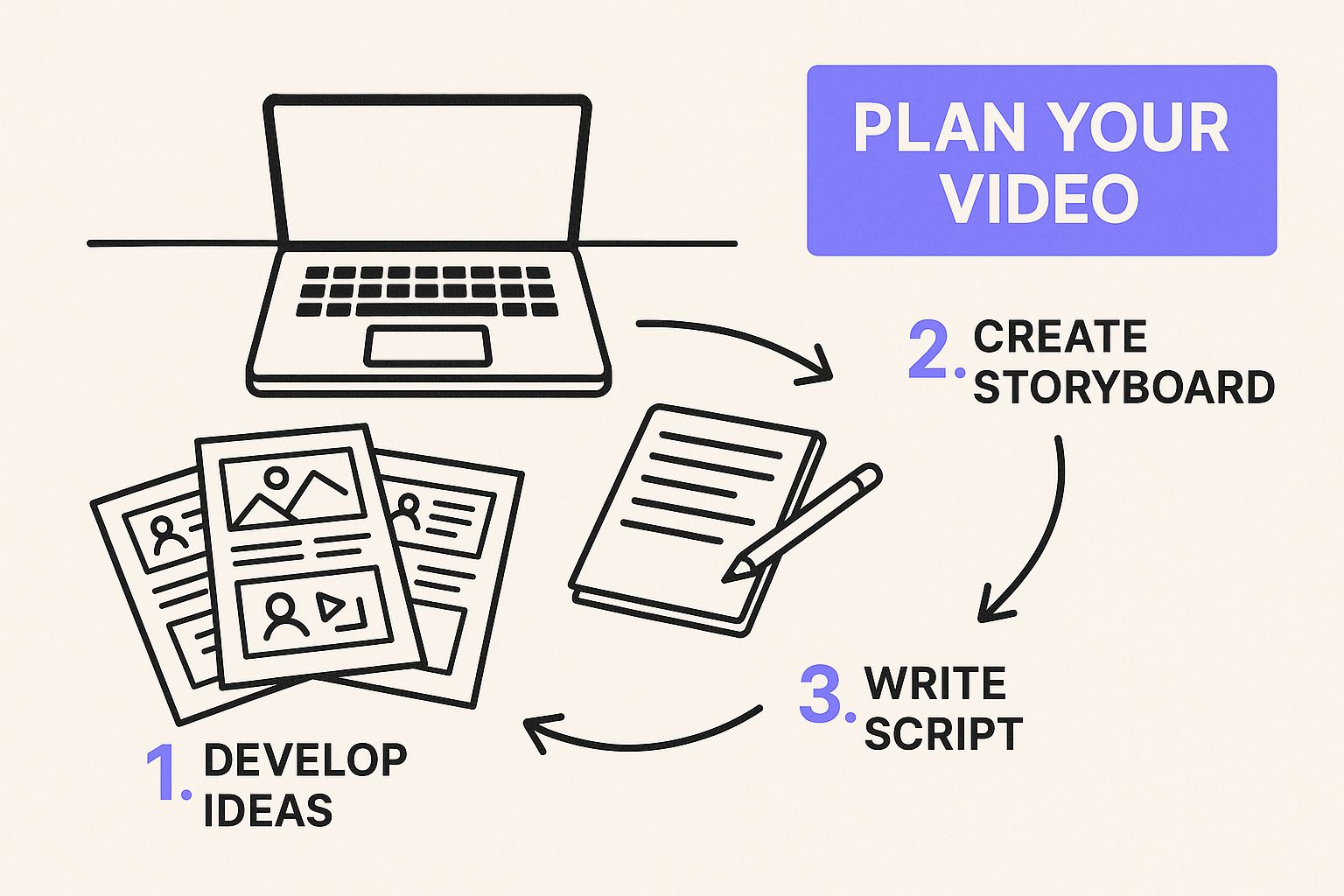
This visual shows that scripting and storyboarding aren't just fluffy creative exercises—they are the strategic foundation for a video that actually gets results.
Before you jump into production, it’s worth taking a moment to organize your pre-production steps. This simple checklist ensures you've covered all the critical planning bases before the camera starts rolling.
Essential Pre-Production Checklist
| Planning Stage | Key Objective | Example Action |
|---|---|---|
| Audience Persona | Understand who you're talking to. | Create a profile for "Busy Brian," a 35-year-old project manager. |
| Primary Goal | Define one clear success metric. | Aim for a 15% increase in demo sign-ups from the video. |
| Core Message | Boil down your value proposition. | "Our app saves you 5 hours of administrative work each week." |
| Script Outline | Structure your story. | Draft a 5-point script following the Hook-Problem-Solution framework. |
| Storyboard | Visualize the key shots. | Sketch 8-10 simple frames for your 60-second video. |
| Logistics | Prepare for the shoot. | Book the location, confirm talent, and check your equipment list. |
Having this checklist ticked off gives you the confidence that you’re fully prepared to create something great.
Crafting a Compelling Script
With your audience and goal locked in, writing the script becomes so much simpler. This is where you translate your product's benefits into a real story. Please, don't just list features. Tell a story that connects with your viewer's actual problems and aspirations.
Consumer habits have completely changed. An incredible 72% of consumers now prefer watching a video to learn about a product instead of reading about it. And get this: six out of ten people prefer online videos to watching traditional TV. The shift to on-demand content is undeniable.
A great script usually follows a simple, proven structure:
- The Hook: You have about three seconds to grab their attention. Start with a sharp question, a surprising stat, or a problem they know all too well.
- The Problem: Clearly state the pain point your audience deals with. You want them nodding in agreement.
- The Solution: Introduce your product as the hero that solves that specific problem.
- The Proof: This is the "show, don't tell" part. Demonstrate the product in action and highlight how it delivers on its promise.
- The Call to Action: Be direct. Tell the viewer exactly what to do next—visit your site, sign up for a demo, or buy now.
Using a problem-solution framework is one of the most effective ways to script a product video. It grounds your product in a real-world context and immediately establishes its value to the viewer.
Storyboarding Your Vision
A storyboard is just a visual outline of your video, shot by shot. It doesn’t have to be a masterpiece—stick figures and rough sketches work just fine. The real purpose is to translate your script into a visual plan so everyone on your team knows exactly what shots you need on filming day.
This simple step saves an unbelievable amount of time during production. It helps you figure out the pacing, spot potential problems early, and make sure your final video tells a cohesive visual story. In fact, many of the same strategies used in high-level corporate content apply here. For instance, learning how to create engaging training videos can offer powerful insights into structuring persuasive visual content. Good planning is truly universal.
Shooting High-Quality Video on a Budget
https://www.youtube.com/embed/NPrkxj2MyZI
You don't need a Hollywood film crew or a mountain of expensive gear to make a great product video. Honestly, the smartphone you have right now is an incredible tool, more than capable of capturing beautiful footage. The real secret isn't throwing money at the problem—it's about getting smart with what you already have.
When people first learn how to create product videos, they often get stuck on the equipment list. But the pros know that amazing results come from mastering the fundamentals: lighting, stability, and sound. If you can get those three things right, your videos will immediately look and feel more professional, building trust with your audience without emptying your wallet.
Master Your Lighting with DIY Setups
Let's be clear: lighting is everything. It sets the mood, makes your product's best features pop, and is the single biggest difference between a polished video and a homemade one. The good news? Great lighting doesn't have to cost a dime.
Your best (and cheapest) light source is a big window. Natural sunlight is soft, flattering, and makes almost any product look fantastic. Just set up your shot so the light hits your product from the front or the side. Try to avoid shooting with the window directly behind your product, as that can throw it into a dark silhouette.
If you’re shooting at night or stuck in a room without good natural light, you can easily build your own simple setup:
- Key Light: This is your main, brightest light. A simple desk lamp or any bright household light will work. Position it at about a 45-degree angle to your product.
- Fill Light: To soften up the shadows created by your main light, use a second, less powerful lamp on the opposite side. Pro-tip: you can also just use a white foam board or even a piece of paper to bounce light back into the shadowed areas.
- Backlight (Optional): For a little extra polish, try placing a small light behind your product. This helps separate it from the background and creates a subtle, professional-looking halo effect.
The goal here is simple: kill the harsh shadows and make sure your product is evenly lit and easy to see. Play around with where you place your lights until your product looks its absolute best.
Essential Smartphone Camera Techniques
Think of your smartphone as your go-to camera, but a few simple tricks can take your shots from looking like a quick phone snap to something far more cinematic. First and foremost, you need stability. A shaky camera is a dead giveaway of an amateur video and can be seriously distracting for your viewers.
The single best investment you can make is a cheap, basic tripod. It guarantees your shots are steady and level, plus it frees up your hands. No tripod? No problem. Just find a solid surface, like a stack of books, to prop up your phone.
Once your phone is stable, it's time to get creative and make your shots more interesting:
- Vary Your Angles: Don’t shoot everything from the same boring, head-on perspective. Get in close for detail shots, shoot from a low angle to make the product look more impressive, or try a top-down shot for a clean, modern vibe.
- Create Subtle Movement: You don't need a slider to add motion. If you've got a steady hand, try a slow, controlled pan across the product or a gentle push-in to highlight a key feature.
- Use the Rule of Thirds: This is a classic composition trick for a reason. Imagine your screen is divided by a 3x3 grid. Instead of sticking your product right in the middle, place it along one of the lines or where the lines intersect. It instantly makes your shot feel more balanced and professional.
Remember, every single shot should communicate value. A close-up on the detailed stitching shows off quality, while a wider shot of the product being used in a real-life setting helps your customers picture it in their own lives.
Capturing Crystal-Clear Audio
Here’s a hard truth: viewers will forgive video that’s a little grainy, but they will absolutely not stick around for bad audio. If your sound is muffled, echoey, or full of background noise, people will click away in seconds. It just feels untrustworthy.
Luckily, the built-in mic on your smartphone is actually pretty good, as long as you give it a fighting chance by controlling your environment. Your mission is to find the quietest room you possibly can—away from humming refrigerators, loud air conditioners, or traffic noise.
Here’s a quick checklist for getting better sound on a budget:
- Find a Quiet Space: Rooms with soft surfaces are your best friend. Look for a space with carpets, curtains, or lots of furniture to absorb sound and kill echo. A walk-in closet filled with clothes is a surprisingly effective DIY sound booth.
- Get Close to the Mic: Sound quality drops off fast. Keep your phone as close as you can to whatever is making the sound, whether it’s your voice or the product itself.
- Always Do a Test: Before you film everything, record a quick 10-second test clip. Listen back with headphones. You’ll be amazed at what you hear—this is your chance to catch that low hum or slight echo you missed earlier.
By focusing on these three fundamentals—lighting, stability, and audio—you can create product videos that look and sound fantastic, all without spending a fortune.
Editing Your Video with AI-Powered Tools
You’ve finished shooting, and now you have a folder full of raw clips. This is where the real magic happens. Editing is when your story finally takes shape, and thanks to modern AI tools, it’s no longer the soul-crushing, time-consuming process it once was.
Forget spending weeks learning complicated software. With a platform like Sprello powering your workflow, you can turn that raw footage into a polished, professional product video faster than you can brew a pot of coffee. The whole point is to be efficient and create something that makes an impact, without getting lost in the technical weeds.
Just look at how simple Sprello makes the whole process. Everything you need is right there.
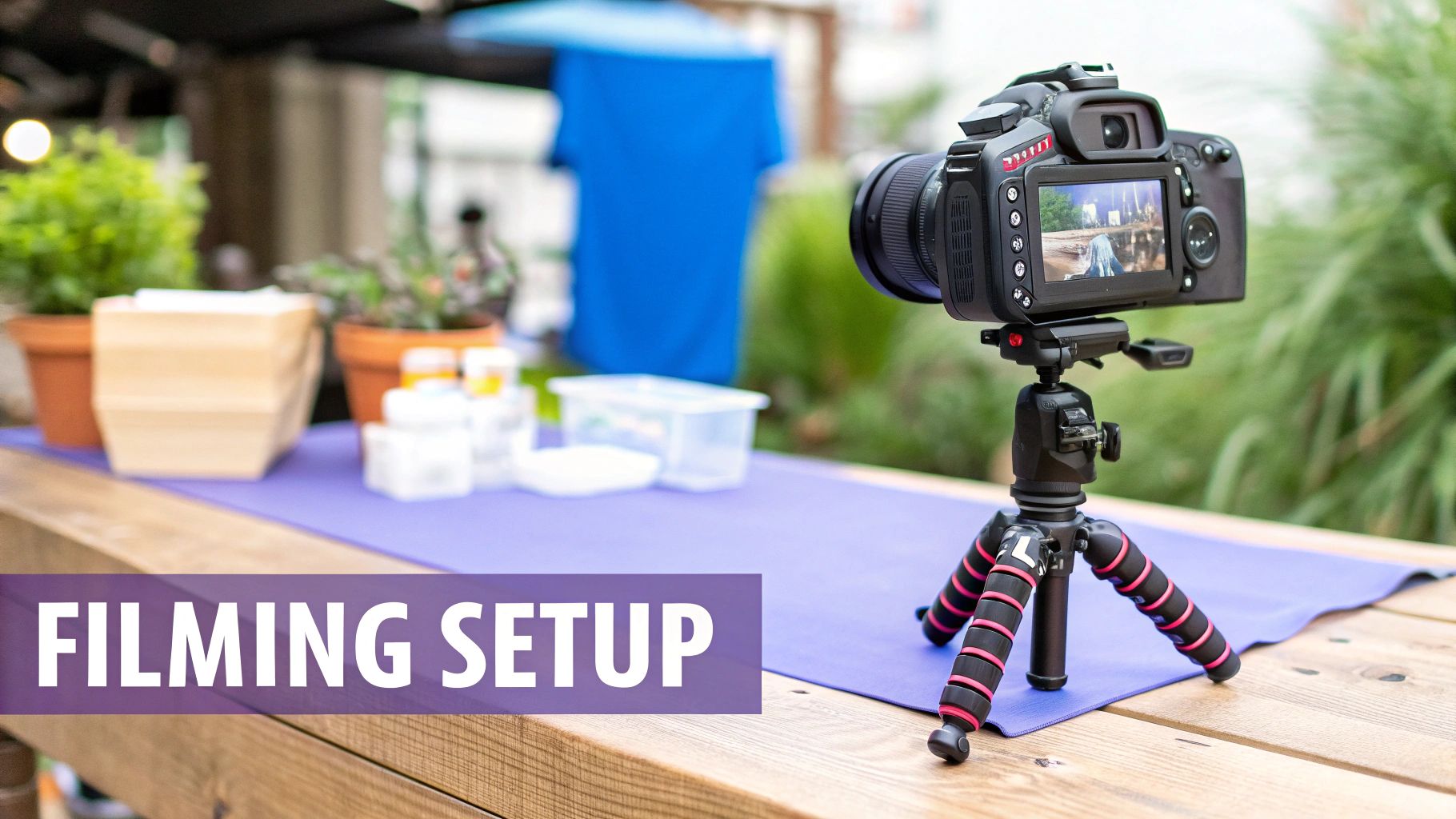
The clean interface lets you drag and drop media, tweak text, and get a finished video with just a few clicks. It’s built for speed.
First, Nail the Editing Fundamentals
Before we let the AI do the heavy lifting, let's cover the foundational edits that give any video a professional sheen. These are the small, deliberate touches that make a massive difference in how people see your brand. A smooth, well-paced video just feels more trustworthy.
Think of these as the building blocks for a great video:
- Trim for Pacing: Nobody has time for awkward pauses or mistakes. Chop them out. Your goal is a tight, energetic video that gets straight to the point and respects your viewer's time. A good trim keeps people watching.
- Add Text Overlays: Slap some text on the screen to call out key benefits, a special discount, or an important feature. This is non-negotiable, as most people on social media watch with the sound off. Your main message has to land, with or without audio.
- Choose the Right Background Music: Music sets the mood instantly. Do you want your video to feel exciting? Trustworthy? A bit quirky? Finding a track that matches your brand's personality is key to making an emotional connection.
Getting these basics right turns a jumble of raw clips into a cohesive story that actually sells your product.
Let AI Speed Up Your Workflow
This is where things get really interesting. Features that used to take hours of painstaking manual work are now almost instant, freeing you up to focus on the creative side of things.
The shift here has been massive. The percentage of marketers using AI in video production shot up from just 18% in 2023 to 41% in 2024. That kind of jump tells you everything you need to know—this technology is making high-quality video accessible to everyone.
Here are a few AI features that will completely change how you edit:
- Automatic Subtitles: With one click, AI can listen to your audio and generate perfectly timed subtitles. This is a game-changer for accessibility and engagement, especially for silent-viewers on platforms like Instagram and Facebook.
- Smart Scene Detection: Slicing a long clip into smaller, usable scenes is a tedious job. AI can analyze your footage and automatically identify every time the scene changes, breaking it all down into manageable chunks for you.
- AI Color Correction: Trying to get your colors to look just right can be a frustrating exercise in trial and error. AI-powered tools can automatically balance the colors, tweak the saturation, and adjust the brightness to make your product look incredible.
AI isn't here to replace your creativity—it's here to amplify it. By taking over the repetitive, technical stuff, these tools give you the freedom to experiment and get your message just right, in a fraction of the time.
Putting It All Together for a Polished Final Cut
Okay, you’ve trimmed your clips, added music and text, and let the AI work its magic. Now for the final step: watch the whole thing from start to finish.
Be critical. Does the story make sense? Does it drag anywhere? And most importantly, is your call to action crystal clear?
This final polish is what separates an okay video from a great one. You want every single element, from the visuals to the audio, to work together toward your goal. After all, the point of a product video is to get someone to take action, and a clean, professional edit makes that far more likely.
If you’re applying these techniques to paid ads, our guide on how to https://sprello.ai/blog/create-video-ads-with-ai offers more specific strategies to get the best results.
Distributing Your Video for Maximum Reach
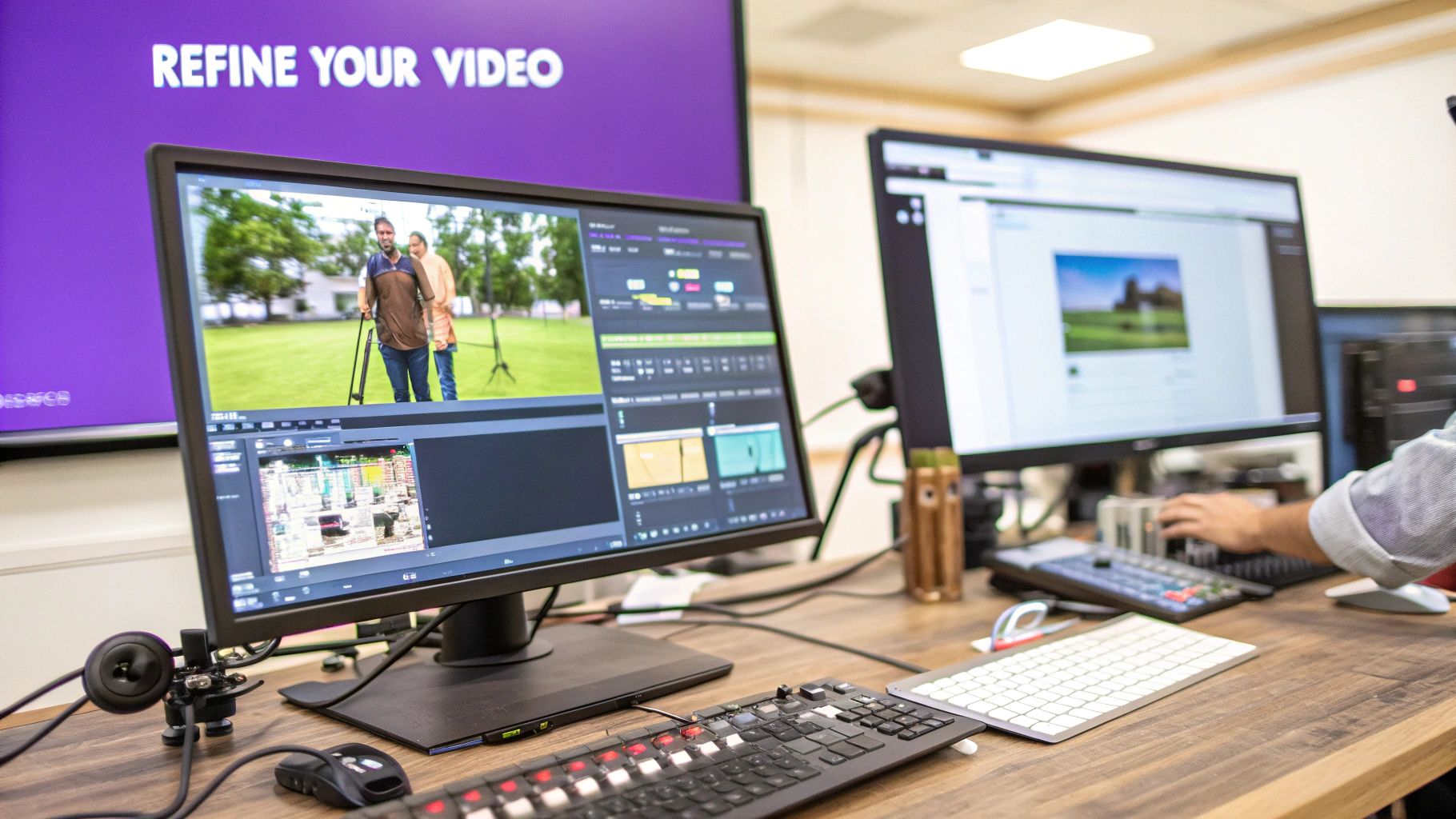
You've done the hard work and created a fantastic product video. That's a huge win, but it's really just half the battle. After all, what good is a masterpiece if no one ever sees it?
Now it’s time to get that video in front of the right people. This isn't about just throwing it out there and hoping for the best. A smart distribution strategy is what turns views into loyal customers. Let's get into how you can make sure your video actually performs.
First Things First: Optimize for Discovery
Before you share your video anywhere, you need to make sure people can find it organically. Think of your video as a powerful piece of content that needs some basic SEO love, especially on a platform like YouTube, which is basically the second-biggest search engine on the planet.
A killer title is your first hook. It has to grab a person's attention while also telling the search algorithm exactly what your video is about. So, instead of a boring title like "Product Demo," you could try something far more specific and helpful, like "How to Set Up Your Smart Home Hub in Under 5 Minutes."
Next up is your video description. This space is SEO gold. Don't just toss in a single sentence; write a solid paragraph or two explaining the video's value. Weave in your main keywords naturally and—this is key—drop a link to your product page right at the top so people can click through immediately.
And don't forget your tags! Put yourself in your customer's shoes. What words would they type into a search bar to find a solution like yours? Use those phrases, along with your brand name and product name, as tags.
Design a Thumbnail That Begs to Be Clicked
In a sea of content, your thumbnail is your video's billboard. It's often the single thing that determines whether someone watches your video or just keeps scrolling. A great thumbnail is clean, compelling, and sparks a little curiosity.
Here are a few tips I've picked up for creating winning thumbnails:
- Use a high-quality, expressive image. A close-up of someone having a great experience with your product is almost always a solid bet.
- Add bold, easy-to-read text. Just a few words highlighting the main benefit can make a huge difference in your click-through rate.
- Make it pop with color and contrast. Stick to your brand palette, but use bright colors that stand out in a crowded feed.
Your thumbnail's job is to make a promise. It should accurately represent the video's content while being intriguing enough to earn the click. Mismatched expectations are a quick way to lose a viewer's trust.
Create a Multi-Channel Distribution Plan
With your video fully optimized, it's time to get it out there. The goal is simple: meet your audience where they already hang out.
Your product page is, without a doubt, the most critical placement. Embedding your video directly on the page can boost conversion rates by as much as 80%. It's right there at the point of decision, answering last-minute questions and building the confidence a customer needs to click "buy."
Email is another powerhouse channel you can't ignore. Share your new video with your subscribers to warm up leads or re-engage past customers. Did you know that including a video in an email can increase click-through rates by up to 300%? It’s an incredible way to drive targeted traffic back to your site. You can also provide even more value by linking to a detailed guide, like our article on how to create product demo videos automatically: https://sprello.ai/blog/create-product-demo-videos-automatically.
Slice and Dice Your Content for Social Media
Let's be real: the video you put on your website isn't going to fly on TikTok. Every platform has its own vibe, and your content needs to adapt. This is where repurposing becomes your best friend.
Take your main video and chop it into bite-sized clips that are perfect for social media. A quick 30-second highlight reel showing off the product's coolest feature can be a real scroll-stopper on a fast-moving feed.
Platform-Specific Video Optimization
To give you a clearer picture, I've put together a quick cheat sheet for tailoring your video content to different channels.
| Platform | Ideal Length | Key Optimization Tactic |
|---|---|---|
| Website / Product Page | 1-3 minutes | Embed it right at the top. Focus on showing detailed benefits and building trust. |
| YouTube | 2-5 minutes | Go all-in on SEO with a strong title, description, and tags to win the search game. |
| Instagram Reels / TikTok | 15-60 seconds | Use a vertical format, jump on trending audio, and get straight to the good stuff. |
| 30-90 seconds | Keep it professional. Add captions for silent viewers and focus on the business value. |
Thinking beyond these basics, some brands are getting incredible results by leveraging influencer gifting and AI for product seeding, which can seriously amplify your reach.
By putting a solid distribution plan in place, you’re not just releasing a video—you’re launching a strategic asset that will pay off with real, measurable results.
Your Product Video Questions, Answered
Even with the best plan, you're going to have questions as you dive into making product videos. It’s just part of the process. Let’s walk through some of the big ones that pop up all the time so you can get past them and focus on creating something great.
Getting these fundamentals down will clear the path and help you build momentum.
How Long Should My Product Video Be?
Ah, the million-dollar question. The honest answer? It really depends on where people will see it and what you want them to do. There's no magic number, but there are definitely some solid guidelines that work.
If you're aiming for social media feeds like TikTok or Instagram Reels, you’ve got to be fast. Think 15-60 seconds. The whole game there is to grab attention instantly, make a single point, and get out.
For a product page on your website or a platform like YouTube, you have a little more breathing room. Something in the 1-3 minute range usually hits the mark. That’s enough time to show off the key features and really explain the benefits without your viewer's attention drifting.
My rule of thumb is this: be as long as you need to be, but as short as you can be. Every second has to earn its place. If a shot doesn't push the story forward, it needs to go.
Do I Really Need a Fancy Camera?
Nope. Not at all. This is probably the biggest myth that stops people from even trying. The camera in your smartphone is an absolute powerhouse—more than capable of shooting crisp, beautiful 4K video.
Forget about spending thousands on gear. Instead, pour your energy into the things that actually make a video look and feel professional:
- Great Lighting: Natural light from a window is your best friend. If that's not an option, a couple of simple, cheap lamps can make a world of difference.
- Steady Shots: Shaky footage screams amateur. A basic tripod is a small investment that pays off big time in professionalism.
- Clean Audio: Find a quiet room. Bad audio is often more distracting than bad video. You want people to hear your message clearly.
Nail these three basics, and your videos will look better than someone with a high-end camera who ignores them.
What’s the Single Most Important Part of a Product Video?
It’s not the stunning visuals or the slick editing, though those help. The most crucial element of any product video is the script and the story you tell. You can have the most gorgeous-looking video ever, but if the message doesn't land, it’s not going to work.
A great script does more than just list features; it connects with your viewer. It should pinpoint a problem they have and perfectly position your product as the solution. That narrative is what persuades people and makes your video stick in their minds. Authenticity is a huge part of this, which is why looking at the benefits of user-generated content can be a fantastic source of inspiration for writing scripts that feel real and build trust.
How Do I Know if My Video Is Actually Working?
Success is way more than just the view count. The metrics that matter are the ones tied directly to the goal you set in the first place.
What was your objective?
- Brand Awareness: Keep an eye on views, reach, and how many people are sharing it.
- Engagement: Look at watch time, likes, and especially comments. Are people talking?
- Sales: This is the bottom line. Track the click-through rate from the video to your product page and, most importantly, the conversion rate. How many viewers turned into buyers?
Every platform, from YouTube Studio to Meta Business Suite, has its own analytics dashboard. Use them. That data tells you the real story of what’s resonating with your audience and what you should do differently next time.
Ready to stop worrying about the technical details and start creating product videos that truly perform? With Sprello, you can turn your ideas into high-impact, UGC-style video ads in minutes, all powered by AI. No actors, no complicated editing—just results. Start your free trial and see how easy it is to create your next winning video at https://sprello.ai.
